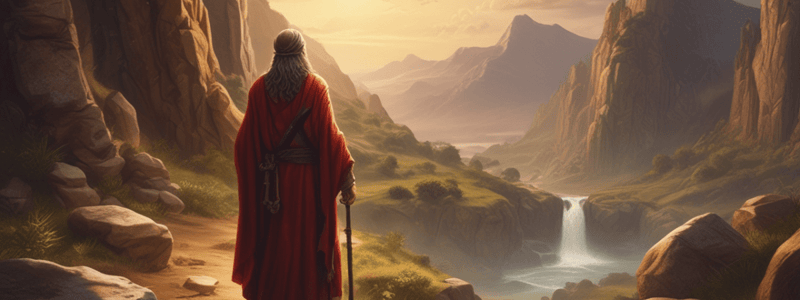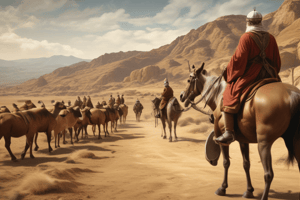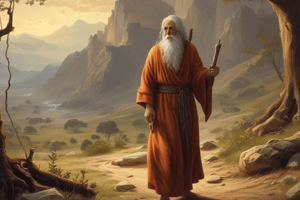Podcast
Questions and Answers
The tabernacle's dimensions were larger than a football field in length and width.
The tabernacle's dimensions were larger than a football field in length and width.
False (B)
The holy of holies contained the lamp stand and the showbread.
The holy of holies contained the lamp stand and the showbread.
False (B)
The priestly family camped to the west of the tabernacle.
The priestly family camped to the west of the tabernacle.
False (B)
The tribe of Judah camped to the north of the tabernacle.
The tribe of Judah camped to the north of the tabernacle.
The individual tents of the approximately three million people made up the tribe of Levi.
The individual tents of the approximately three million people made up the tribe of Levi.
The cloud by day and fire by night indicated the presence of the Levites.
The cloud by day and fire by night indicated the presence of the Levites.
The ark of the covenant was made of silver.
The ark of the covenant was made of silver.
The non-priestly families of the tribe of Levi camped to the east of the tabernacle.
The non-priestly families of the tribe of Levi camped to the east of the tabernacle.
The priests would carry the lamp stand when the tabernacle was to be moved.
The priests would carry the lamp stand when the tabernacle was to be moved.
The tribe of Benjamin camped to the east of the tabernacle.
The tribe of Benjamin camped to the east of the tabernacle.
The book of Numbers emphasizes the Israelites' initial obedience to Yahweh.
The book of Numbers emphasizes the Israelites' initial obedience to Yahweh.
The narrative of the first generation of Israel ends on a note of success in Numbers 25.
The narrative of the first generation of Israel ends on a note of success in Numbers 25.
Yahweh's ultimate purpose is to curse Israel with the wilderness experience.
Yahweh's ultimate purpose is to curse Israel with the wilderness experience.
The book of Numbers can be divided into two geographical sections: Sinai and the wilderness.
The book of Numbers can be divided into two geographical sections: Sinai and the wilderness.
The census in Numbers 26 is irrelevant to the Torah as a whole.
The census in Numbers 26 is irrelevant to the Torah as a whole.
The story of Zelophehad's daughters in Numbers 26 and 27 is a story of disobedience.
The story of Zelophehad's daughters in Numbers 26 and 27 is a story of disobedience.
The book of Numbers has a narrative cycle that begins in chapter 1 and completes in chapter 36.
The book of Numbers has a narrative cycle that begins in chapter 1 and completes in chapter 36.
The book of Numbers has only one major division.
The book of Numbers has only one major division.
The structure of Numbers does not fit into the overall structure of the Torah.
The structure of Numbers does not fit into the overall structure of the Torah.
The book of Numbers has an abundance of commentary and resource support.
The book of Numbers has an abundance of commentary and resource support.
The tabernacle consisted of a courtyard and the holy of holies only.
The tabernacle consisted of a courtyard and the holy of holies only.
The Levites camped around the tabernacle in a specific order.
The Levites camped around the tabernacle in a specific order.
The ark of the covenant was placed in the holy place.
The ark of the covenant was placed in the holy place.
The tribes of Judah, Issachar, and Zebulun camped to the west of the tabernacle.
The tribes of Judah, Issachar, and Zebulun camped to the west of the tabernacle.
The cloud by day and fire by night indicated the presence of the Levites around the tabernacle.
The cloud by day and fire by night indicated the presence of the Levites around the tabernacle.
When the tabernacle was to be moved, the priests would quickly cover and disassemble it.
When the tabernacle was to be moved, the priests would quickly cover and disassemble it.
The tribe of Levi camped to the south of the tabernacle.
The tribe of Levi camped to the south of the tabernacle.
The lamp stand and the showbread were placed in the courtyard.
The lamp stand and the showbread were placed in the courtyard.
The non-priestly families of the tribe of Levi were responsible for carrying the ark of the covenant.
The non-priestly families of the tribe of Levi were responsible for carrying the ark of the covenant.
The individual tents of the approximately three million people made up the tribe of Levi and the camp of Israel.
The individual tents of the approximately three million people made up the tribe of Levi and the camp of Israel.
The book of Numbers focuses on the Israelites' experience in the wilderness, which lasted for 35 years.
The book of Numbers focuses on the Israelites' experience in the wilderness, which lasted for 35 years.
The narrative of the second generation of Israel begins in Numbers 25.
The narrative of the second generation of Israel begins in Numbers 25.
The book of Numbers can be divided into four geographical sections.
The book of Numbers can be divided into four geographical sections.
The story of Zelophehad's daughters in Numbers 26 and 27 is a unique example of disobedience in the census.
The story of Zelophehad's daughters in Numbers 26 and 27 is a unique example of disobedience in the census.
The book of Numbers has a narrative cycle that begins in chapter 1 and completes in chapter 36.
The book of Numbers has a narrative cycle that begins in chapter 1 and completes in chapter 36.
Yahweh's ultimate purpose is to bless Israel with the gift of the wilderness experience.
Yahweh's ultimate purpose is to bless Israel with the gift of the wilderness experience.
The census in Numbers 26 is a minor event in the book of Numbers.
The census in Numbers 26 is a minor event in the book of Numbers.
The book of Numbers has a clear organization and coherence, but lacks a storyline.
The book of Numbers has a clear organization and coherence, but lacks a storyline.
The narrative of the first generation of Israel ends on a note of success in Numbers 25.
The narrative of the first generation of Israel ends on a note of success in Numbers 25.
The book of Numbers is a prominent book in evangelical preaching and pulpits.
The book of Numbers is a prominent book in evangelical preaching and pulpits.
The book of Numbers has a narrative cycle that begins in chapter 26-27 and completes in chapter 36.
The book of Numbers has a narrative cycle that begins in chapter 26-27 and completes in chapter 36.
The census in Numbers 26 is vital to the Torah as a whole.
The census in Numbers 26 is vital to the Torah as a whole.
The book of Numbers emphasizes the Israelites' initial disobedience to Yahweh.
The book of Numbers emphasizes the Israelites' initial disobedience to Yahweh.
The story of Zelophehad's daughters in Numbers 26 and 27 is an example of disobedience in the census.
The story of Zelophehad's daughters in Numbers 26 and 27 is an example of disobedience in the census.
The book of Numbers can be divided into three geographical sections: Sinai, the wilderness, and the Plains of Moab.
The book of Numbers can be divided into three geographical sections: Sinai, the wilderness, and the Plains of Moab.
Yahweh's ultimate purpose is to curse Israel with the wilderness experience.
Yahweh's ultimate purpose is to curse Israel with the wilderness experience.
The book of Numbers has an abundance of commentary and resource support.
The book of Numbers has an abundance of commentary and resource support.
The book of Numbers focuses on the Israelites' experience in the wilderness, which lasted for 37 and a half years.
The book of Numbers focuses on the Israelites' experience in the wilderness, which lasted for 37 and a half years.
The narrative of the first generation of Israel ends on a note of success in Numbers 25.
The narrative of the first generation of Israel ends on a note of success in Numbers 25.
The book of Numbers has a clear organization and coherence, but lacks a storyline.
The book of Numbers has a clear organization and coherence, but lacks a storyline.
The tabernacle's dimensions were larger than a football field in length and width.
The tabernacle's dimensions were larger than a football field in length and width.
The tribe of Levi, camped to the south of the tabernacle.
The tribe of Levi, camped to the south of the tabernacle.
The ark of the covenant was placed in the holy place.
The ark of the covenant was placed in the holy place.
The lamp stand and the showbread were placed in the courtyard.
The lamp stand and the showbread were placed in the courtyard.
The cloud by day and fire by night indicated the presence of the Levites around the tabernacle.
The cloud by day and fire by night indicated the presence of the Levites around the tabernacle.
The tribe of Judah, Issachar, and Zebulun camped to the east of the tabernacle.
The tribe of Judah, Issachar, and Zebulun camped to the east of the tabernacle.
The Levites were responsible for carrying the ark of the covenant.
The Levites were responsible for carrying the ark of the covenant.
The tabernacle consisted of a courtyard and the holy of holies only.
The tabernacle consisted of a courtyard and the holy of holies only.
The individual tents of the approximately three million people made up the tribe of Levi.
The individual tents of the approximately three million people made up the tribe of Levi.
The ark of the covenant was made of silver.
The ark of the covenant was made of silver.
Flashcards are hidden until you start studying
Study Notes
- The tabernacle was in the midst of Israel, and its dimensions were less than a football field in length and width, making it impossible to play 11-man football inside.
- The tabernacle consisted of a courtyard, an altar, a laver for the priest to wash, the holy place with an outer compartment, the lamp stand, the showbread, the altar of incense, the veil, and the holy of holies where the ark of the covenant was placed.
- The ark of the covenant was made of gold, had the mercy seat on top, and was where Aaron would bring the blood on the day of atonement for Israel.
- The tribe of Levi, including the priestly family and non-priestly families, camped around the tabernacle, with the priests to the east, and were responsible for cleaning, carrying, and maintaining the tabernacle.
- The other 12 tribes camped around the tribe of Levi, with Judah, Issachar, and Zebulun to the east, Dan, Asher, and Naphtali to the north, Ephraim, Manasseh, and Benjamin to the west, and Reuben, Simeon, and Gad to the south.
- The individual tents of the approximately three million people made up the camp of Israel.
- When the tabernacle was to be moved, the Levites would quickly cover and disassemble it, and the priests would carry the ark of the covenant, followed by the tribes in a specific order.
- The cloud by day and fire by night above the ark of the covenant indicated Yahweh's presence, guiding Israel's movement.
- During the 37 and a half years of Israel's wandering in the wilderness, the organization and structure around the tabernacle broke apart, and the people became semi-nomadic.
- The book of Numbers emphasizes obedience and disobedience, with chapters 11-25 focusing on the failure of Israel to obey Yahweh in faith, resulting in Yahweh's discipline by death.
- The narrative of the first generation of Israel ends on a note of failure in Numbers 25, with Israel participating in idolatry and worshiping Baal instead of Yahweh.
Here is the summary of the text in detailed bullet points:
• Yahweh's ultimate purpose is to bless Israel with the gift of the land and the ultimate King, as seen in Numbers 23 and 24, which reminds us of the Abrahamic covenants.
• Despite the failure of the first generation, Yahweh's purpose is not frustrated, as seen in the end of Deuteronomy, where Moses blesses the people before his death.
• Numbers 25 marks a significant division in the book, as it concludes the narrative concerning the first generation of Israel and begins the narrative of the second generation.
• The book of Numbers can be seen as a "trash heap" of the Torah, where Moses or the final editors put various material that didn't fit elsewhere in the Torah.
• The literary structure of Numbers can be divided into three geographical sections: Sinai (chapters 1-9), the wilderness (chapters 10-22), and the Plains of Moab (chapters 23-36).
• The first 25 chapters of Numbers conclude the narrative concerning the first generation of Israel, while the census in Numbers 26 begins the narrative of the second generation.
• The census in Numbers 26 is vital to the Torah as a whole, as it prepares Israel for the conquest of the land and its distribution among the tribes, which is continued in the book of Joshua.
• The narrative of Numbers 26 and 27 is echoed in Deuteronomy 31-34, where Moses reminds Israel to take the land that God has given them as an inheritance.
• The story of Zelophehad's daughters in Numbers 26 and 27 is a unique example in the census, where they request to inherit their father's land since he had no sons, and God grants their request.
• The daughters of Zelophehad are an example of the change that has taken place between the first and second generation of Israel, as they obey God's command and marry within their own tribe to maintain their inheritance.
• The narrative of Zelophehad's daughters is completed in Numbers 36, where they fulfill God's command and marry within their own tribe.• The book of Numbers has a narrative cycle that begins in chapter 26-27 and completes in chapter 36, showcasing 11 chapters as a whole unit.
• The cycle begins with the Lord's command and ends with the Lord's commands, highlighting the distribution of land to the tribes based on their size, with larger tribes receiving larger inheritances.
• A break is seen in Numbers 33-50, where the Lord reiterates the distribution of land based on the tribe's size.
• The book of Numbers has two major divisions: the first 25 chapters, which chronicle the history of the first generation of Israel, particularly their experience in the wilderness, and the last 11 chapters, which focus on the renewed experience of the second generation.
• The first 10 chapters of Numbers show the Israelites' initial obedience, with their organization and orientation centered around the tabernacle, whereas chapters 11-21 show their disobedience.
• Chapter 22 marks the final rebellion, preceded by Yahweh's blessing pronounced through Balaam.
• Chapters 26-36 depict the renewed experience of the second generation, with preparation and anticipation for the conquest of the land.
• The structure of Numbers fits into the overall structure of the Torah, with a clear organization, coherence, and storyline.
• In contrast to other books of the Torah, Numbers has limited commentary and resource support, making it a neglected area in evangelical preaching and pulpits.
• Dennis Cole's commentary in the New American Commentary (NAC) is a notable exception, providing a good interaction with the book of Numbers.
• Other influential commentaries on Numbers include Gordon Wenham's Tyndale Commentary, Timothy Ashley's work in the New International Commentary on the Old Testament (NICOT), and Roland Allen's contribution to the Expositor's Bible Commentary.
• The lack of resources on Numbers reflects its perceived dryness and lack of demand from preachers, making it an area that is often overlooked in church teaching and preaching.
Studying That Suits You
Use AI to generate personalized quizzes and flashcards to suit your learning preferences.



